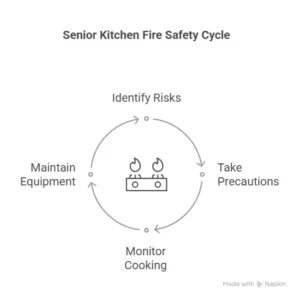
Understanding the unique fire risks that seniors face is critical to ensuring their safety at home. Several factors increase the risk for older adults, making fire prevention and preparedness an essential part of senior home safety.
Statistics show that seniors face a significantly higher risk of fire-related injuries and fatalities compared to the general population. The main contributing factors include:
| Risk Factor | Explanation |
|---|---|
| Limited Mobility | Slower response times can make quick evacuation difficult. |
| Hearing Loss | Difficulty hearing smoke alarms or emergency alerts. |
| Cognitive Decline | Conditions such as Alzheimer’s disease can impair the ability to recognize danger. |
| Physical Limitations | Weakness and coordination challenges can hinder emergency response. |
Due to these vulnerabilities, it is essential to have a comprehensive fire safety plan tailored to seniors’ needs.
Implementing fire prevention measures is vital to safeguarding the health and lives of seniors. Key steps, such as installing and maintaining smoke alarms, greatly reduce the risk of fatalities.
Smoke Alarms: Properly installed and functioning smoke alarms can cut the risk of dying in a fire by approximately 50%. Install alarms on every level of the home, inside each bedroom, and outside all sleeping areas. Test alarms monthly and replace batteries annually.
Kitchen fires are the leading cause of fire-related injuries among seniors. Key prevention tips include:
Turn pot handles inward while cooking to prevent spills.
Keep a fire extinguisher easily accessible in the kitchen.
Remain in the kitchen while cooking to address potential hazards promptly.
Understanding these risks allows seniors, their families, and caregivers to implement preventative strategies that create a safer living environment. For further guidance, explore our resources on Elderly Home Safety Tips.
Protecting seniors from fire hazards is crucial for those living independently. Implementing a few critical safety measures can significantly reduce risks.
Smoke alarms are one of the most effective tools for fire safety.
| Alarm Type | Placement Recommendations |
| Smoke Alarms | Install on each floor, inside bedrooms, and outside sleeping areas. |
Regularly testing alarms and replacing batteries annually ensures their reliability. For additional home safety advice, visit our Home Modifications for Seniors guide.
Communication-monitored smoke alarms provide verbal alerts, making them especially beneficial for seniors with hearing impairments. These alarms can automatically notify emergency services if activated, ensuring rapid response.
Since the kitchen is a common source of household fires, seniors should take extra precautions:
Turn Pot Handles Inward: Prevent accidents and spills.
Maintain a Fire Extinguisher: Keep it easily accessible and ensure it is regularly inspected.
Stay Present While Cooking: Always supervise food being prepared.
Following these guidelines helps minimize kitchen fire risks. Learn more by visiting our article on Elderly Home Safety Tips.

Having a clear and practiced fire escape plan is essential for seniors, particularly those with mobility challenges.
An effective fire escape plan should ensure that seniors can evacuate safely from any area of the home.
| Action Item | Description |
| Identify Exits | Ensure two accessible exits from every room. |
| Practice the Plan | Conduct regular fire drills to reinforce procedures. |
| Assign Roles | Designate assistance for individuals who may need help evacuating. |
Every room should have clear, accessible exit options. Keep hallways and pathways free of obstacles to facilitate swift evacuations.
| Room Type | Exit Route Options |
| Living Room | Main door or accessible window |
| Bedroom | Bedroom door or ground-level window |
| Kitchen | Back door or secondary exit if available |
After evacuation, it is critical to have a designated meeting location that is safe and accessible for all.
| Meeting Point Feature | Considerations |
| Location | Choose a clearly visible and safe area, such as a neighbor’s yard. |
| Accessibility | Ensure the location is reachable for individuals with mobility limitations. |
| Communication Plan | Establish a method for contacting family members after evacuation. |
A well-developed fire escape plan provides seniors and their caregivers with confidence and security in the event of an emergency. For more insights, visit our Emergency Preparedness Checklist.
Send Us An Email